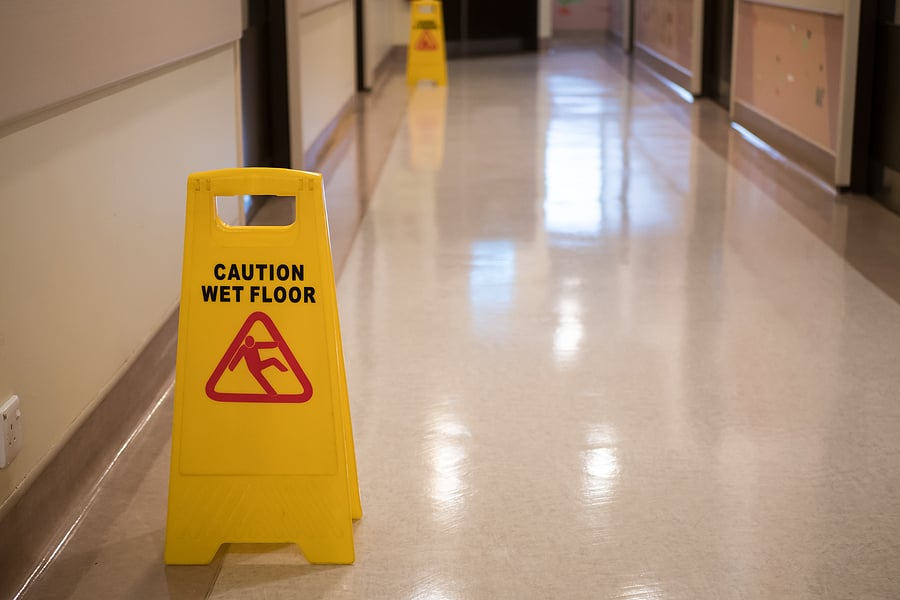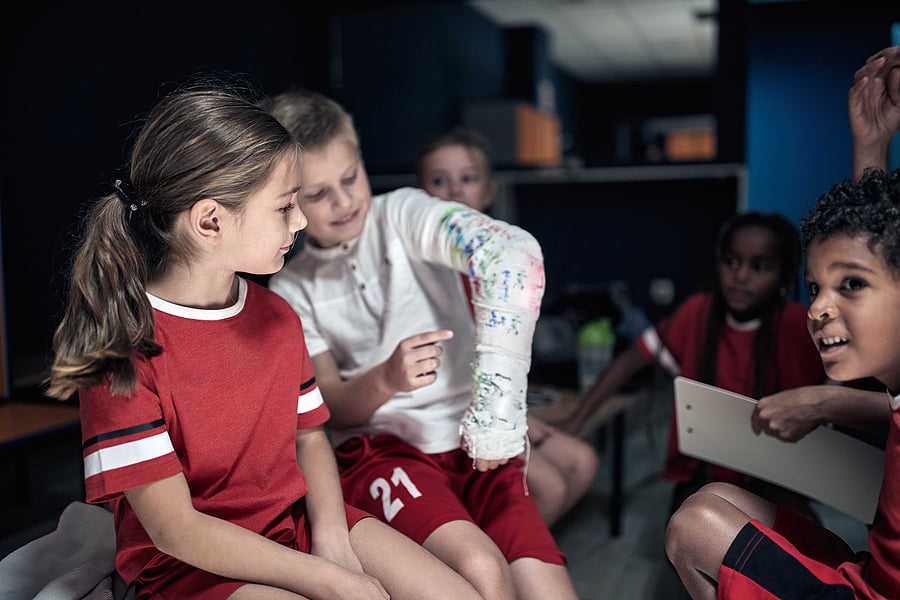What do schools need to do to comply with RIDDOR ?
What is RIDDOR?
RIDDOR stands for the Reporting of Injuries, Diseases and Dangerous Occurrences Regulations 2013. RIDDOR requires employers and others in control of premises to report certain accidents, diseases and dangerous occurrences (near misses) arising out of or in connection with work to the HSE. This also applies to schools, whether an accident happens to a member of staff, student or visitor. Failure to report an incident is breaking the law. It could result in serious consequences for your school.
Most incidents that happen in schools or on school trips won't be RIDDOR reportable but it’s important that you do record and report cases as required. Robust accident recording and reporting also enables you to identify and correct any safety issue.
What Must Schools Report Under RIDDOR?
Under RIDDOR only certain incidents are reportable under RIDDOR. A reportable incident must have happened in relation to the workplace and its related activities. For example, asthma that is triggered by a known irritant in the workplace is reportable. However, an asthma attack caused by a cold and unrelated to work isn’t reportable.
Requirements surrounding reportable incidents differ between staff and students. RIDDOR defines what constitutes a reportable case in both instances.
Reportable Cases Involving Staff
- Result in death or a specified injury.
- Prevent the injured person from continuing their normal work for more than seven days (excluding the day of the incident).
- Lead to a reportable occupational disease, for which the employee has received a written diagnosis from a doctor
Specified staff injuries include:
- Fractures (excluding fingers, thumbs, and toes).
- Amputations.
- Loss or reduction of sight.
- Crush injuries that cause internal organ damage.
- Serious burns (those that cover more than 10% of the body or that damage the eyes, respiratory system, or other vital organs).
- Scalping (skin being separated from the head) that requires hospital treatment.
- Unconsciousness caused by head injury or asphyxia.
- Any injury that results from working in an enclosed space and leads to hypothermia or heat-induced illness, or resuscitation or hospital treatment for over 24 hours.
- Any injury resulting from acts of non-consensual violence in connection to work in a school. For example, if a student injures a teacher during a lesson.
Staff Reportable occupational diseases include:
- Severe cramp of the hand or forearm.
- Hand-arm vibration syndrome.
- Carpal tunnel syndrome.
- Tendonitis or tenosynovitis of the hand or forearm.
- Occupational dermatitis.
- Occupational asthma.
- Any occupational cancer.
- Any disease caused by occupational exposure to a biological agent.
Reportable Cases Involving Students or Visitors
- The incident occurred as a direct result of a work activity or lack of sufficient safety measures in the workplace.
- The person dies or is taken directly from the scene of the accident to hospital for treatment. Note that examinations and diagnostic tests are not considered treatment in this definition.
Students and visitors do not need to have specified injuries for these requirements to apply. Specified injuries apply to employees only.

The incident is reportable if it occurred in relation to:
- Any school activity, both on or off the school premises.
- Equipment, machinery, or substances in the school premises, e.g. equipment used in a woodworking class or chemicals used for a science lesson.
- Poor management or organisation of a school activity, e.g. a lack of supervision.
- Poor design or condition of the premises, e.g. badly maintained floors.
Incidents that are not reportable include:
- Those that happen due to an existing medical condition, e.g. a student with asthma who is taken to hospital following an asthma attack not triggered by something related to how the school operates.
- Those where the person goes to hospital purely as a precaution and has no apparent injury.
- Sports injuries that are not connected to how the school manages the risks from the activity, e.g. those caused by normal ‘rough and tumble’ of the game.
- Playground accidents due to collisions, slips, trips, and falls that are not related to the condition of the premises or the level of supervision.
- Violence between pupils.
- Injuries caused while travelling on a school bus, that result from a road traffic accident. These are classed as road traffic incidents and are investigated by the police. However, if pupils are getting on and off the bus and are injured and taken to hospital due to a vehicle striking the bus, this is reportable.
- Any incidents involving pupils on overseas trips.
- Incidents involving pupils who are elsewhere on a work placement. During work placements, students are considered an employee of the business at which they have a placement. This means that the criteria for reportable incidents involving staff apply and the business is responsible for reporting.
Reportable Dangerous Occurrences (Near Misses)
You should also be aware that certain dangerous occurrences (near misses) are reportable, regardless of whether they may have involved a student or staff member.
These include:
- Load-bearing parts of lifts and lifting equipment collapsing or failing.
- Accidentally releasing a biological agent that is likely to cause severe human illness.
- The accidental release or escape of a substance that may cause serious injury or damage to health.
- An electrical short circuit or overload that causes a fire or explosion.
Examples of Reportable Accidents at School
Let’s look at three different accident scenarios to see whether they would be reportable under RIDDOR
Maintenance Issue v Intended Use
A student is on one of the swings in the playground when a bolt comes loose and causes them to fall off. They land badly on their wrist, which requires them to go to hospital and receive treatment for a fracture. This was caused by poor maintenance of the swing set, and is therefore a reportable incident. If, however, the child had jumped from the swing at height and fallen resulting in the same injury, the incident would not need to be reported under RIDDOR. This injury is a result of the child’s decision to use the swings not for their intended use, so the accident was not caused by anything related to how the school operates.
A Sports Injury
If an accident that results in an injury arises because of the normal rough and tumble of a game, the accident and resulting injury would not be reportable. Four students are using the gym to play tennis during their lunch break. During the match, one of the players falls when running for the ball and sprain their ankle. They need to go to hospital for an x-ray, but because the injury was not caused by something related to how the school operates it is not reportable under RIDDOR.
Slips and Trips
During a PE lesson, one of the students slips on a wet patch on the gym floor, fracturing their ankle. The gym was being cleaned just before the PE lesson, so was not given enough time to dry properly. This is an example of poor management of a school activity and so is reportable under RIDDOR.
Poor Hazard Management
A computer wire in the IT room is fraying and faulty. The class’s teacher unplugged it and intended to remove it from use but forgot to do so. One of the pupils notice that their computer isn’t turning on, so they go to plug in the faulty cable receiving a serious shock requiring hospitalisation. As this was caused by bad management of a hazard in the school, it is therefore a reportable incident.
School Accident and Incident Reporting- submitting a RIDDOR Report
RIDDOR reports must be submitted within 10 days of the incident, though it can be submitted within 15 days if the accident resulted in more than seven days’ absence from work. If the incident is an occupational illness or disease, the report should be submitted as soon as the person receives a diagnosis from their doctor. The report must include the following where relevant:
- The date of the recording.
- The personal details of the individual that the report is about (name, job title, phone number).
- The details of their company (school name, address, email).
- The location, date and time of the incident.
- The personal details of the person(s) involved (name, job title, etc.).
- A description of the injury, illness, or incident.
To submit a report, the responsible person must fill in the relevant form from the HSE, a list of these forms is available here
Recording RIDDOR Incidents
The responsible person should make a note of any incidents that they report to RIDDOR. They should do this in a suitable format, such as in the school’s accident book, and include all the information from the RIDDOR report. If your school has 10 or more employees, it must keep accident records either physically or electronically for at least three years.
About Lisa Robinson
Lisa - word smith to the gods.
Tags: accident reporting



